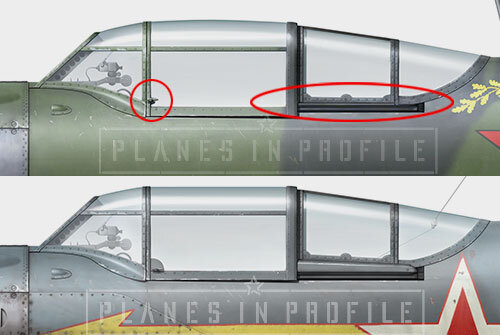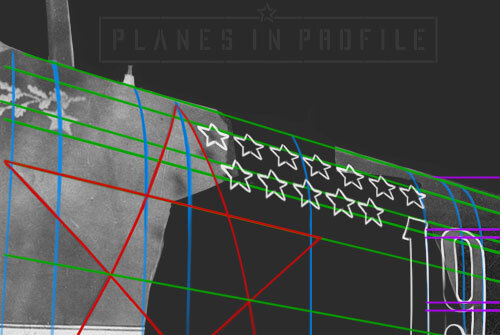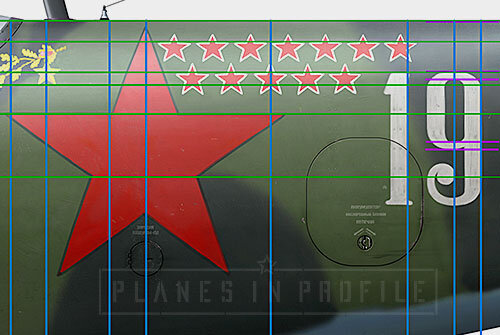(Tokarev’s?) WHITE-19
Lavochkin, La-5F (Type 39)(Early)
40-th GIAP, 8-th GIAD, 5-th IAK, 2-nd Air Army, Voronezhskiy/1-st Ukrainian Front. Summer 1943,
Thought to have been flown by the Commander of the 40-th GIAP, a Hero of the Soviet Union, Moisey Stepanovich Tokarev
PLEASE NOTE! The artwork for ‘White-19’ is based on extremely limited photo reference. The exact camouflage pattern and other visual details on all four sides of the plane are mostly hypothetical. The illustration below is an ‘Educated guess’ as to what ‘White-19’ might have looked like. Please read below to learn more.
40th GIAP was re-armed with La-5 planes in late March to early April 1943 [2]. These were most likely a mix of La-5s and their latest modification, the La-5F Type 37 planes. Type-39 airplanes such as White-19 were built a little later so White-19 was supplied to the regiment some time later. According to some sources, ‘White-19’ was flown by Moisey Tokarev - the commander of the 40-th GIAP himself, and was therefore decorated with Tokarev’s victory stars which he scored up to that point and which earned him the coveted title of the Hero of the Soviet Union. The story about Tokarev’s plane and specifically about the events around the time of Tokarev’s death a few months later diverge into contradicting narratives:
Narrative 1
Tokarev’s plane was decorated with 14 victory stars and in the next few months, while he ripped through the enemy formations in the skies near Kursk, Tokarev took his victory score up to 22 before being shot down himself on the 8th of July 1943. This was three days after the official start of one of the largest German offensives in history, the offensive codenamed ‘Operation Citadel’ aka ‘The Battle of Kursk’ - the largest air battle in history based on the number of planes amassed for the fight, involving about 2500 aircraft on the side of the Luftwaffe and about 2600 aircraft on the side of the Soviet VVS. [3]
When recalling the summer battles of 1943, a Retired Aviation Lieutenant General S.N. Romazanov wrote:
M.S. Tokarev
“Speaking about the skill of our fighters, one involuntarily recalls wonderful people, one after another who, every day, lifted their swift fighters into the air with red stars on their fuselages - the signs of numerous victories in aerial duels. Time is not able to obscure the images of these people, modest in behavior, unselfish in friendship, selflessly brave in battle.
I remember that in one division I met the commander of the fighter regiment, the Hero of the Soviet Union Major M. S. Tokarev, a man of heroic build. In dealing with his comrades, and especially with his superiors, the Major was humble to the point of being shy. Seeing 14 stars on the fuselage of his plane, I asked:
- Probably not all are marked?
The major hesitated and did not answer. I knew, that in addition to the 14 planes shot down by Tokarev in previous battles, and above all in Kuban from where his regiment arrived, he had already shot down several planes at the Kursk bridgehead.
Major Tokarev skilfully led groups of fighters and invariably showed examples of courage and skill in air battles. Once a group led by him met a numerically superior enemy in the air. During the battle, the Major was encircled by 10 enemy fighters. The soldiers of our ground units saw how he shot down 4 enemy fighters. But the forces were too unequal. The Soviet pilot ran out of ammunition. His plane was hit and flew to the ground, uncontrollable. " [4]
Narrative 2
(This narrative is somewhat similar to Narrative 1)
According to one of the regiment’s technicians, Victor Mikhailovich Sinayskiy. Here is how he recalls the events surrounding Tokarev’s death:
At this time, the order came for us to fly . A group of eight was supposed to fly out, Tokarev was no longer supposed to fly out with them. I ran straight to my parking lot, because it was necessary to release the plane.
6 planes took off immediately, then another couple flew out. After some time, only 7 planes returned ...
"Who hasn't come back?" - "The commander of the regiment. Tokarev". - "How? He shouldn't have flown?" At the last moment he set the youngest in the pair aside and decided to fly himself instead. The one who flew with him said that they had passed the front line. They saw that all six were involved in a battle with the ‘Messers’ (this is a ‘nickname’ the Soviets sometimes used in reference to ‘Messerschmitt BF-109’) which the Germans had sent to clear the sky, a group of 60 Ju-87 aircraft were flying below them. Tokarev’s pair attacked this armada, which in addition was covered by 12 Me-109s. He shot down 4 planes and did not let the bombers through. In this battle he was wounded, landed the plane in the location of the tank men, climbed out of the plane and died. We learned all this the next day.
We left for Stary Oskol at night, and in the morning a car arrived there. The colonel tankman, head of the political department brought the coffin with Tokarev's body. And he brought a letter where everything was described. That is why Tokarev died. [5]
Narrative 3
According to Mikhail Bykov’s research, Tokarev’s plane (White-19?) was shot down when Tokarev was returning from the mission mentioned above. M.Bykov writes:
"According to the operational documents of the 8th GIAD, the plane of the commander of the 40th GIAP, Major Tokarev, whose pair was the last in the group of eight La-5, was shot down when returning from a combat mission by a pair of German fighter-hunters by a surprise attack from above - from behind, from the direction of the sun. There was no battle: the German planes left the area of the clash... The "Legend" about the heavy air combat and a large number of enemy aircraft shot down by Tokarev in the last sortie was made up later, apparently to justify the loss of the regiment commander before the command superiors. " [6]
According to Mikhail Bykov’s research, Tokarev’s final victory record stood at 12 personal and 1 shared victory at the time of his death. Tokarev did not score any victories in his La-5F. Mikhail Bykov even questions if ‘White-19’ was Tokarev’s plane, since other pilots such as Nazarenko, were also photographed in front of this plane.
The fact that only 12 stars seem to fit in two rows on the side of ‘White-19’ and the fact that Tokarev had 12 confirmed personal kills according to the documents of the 8th GIAD researched by M. Bykov, seem to help in supporting the idea that ‘White-19’ might have been Tokarev’s plane.
Noteworthy visual characteristics
1) The logo is a cyrillic letter ‘F’ inclosed in a circle. The logo represents the ‘F’ modification of the La-5 variant, letting us know that this is a La-5F plane. The letter ‘F’ is derived from the word ‘Forsirovanniy’ which translates to ‘Forced/boosted’ and essentially refers to the improved ‘Supercharger’ of La-5F’s M-82F engine. (This engine also had an improved oil system to that of M-82A engine of the earlier La-5 planes). The logo usually appeared on the engine cowling and on the tip of the tail, though the one that appeared on the tip of the tail was usually smaller and was painted in white directly over the camouflage colour. In contrast, the logo on the engine cowling was usually painted in red over the top of a white circle background. These logos didn’t always appear on La-5F planes and there is a good chance that ‘White-19’ didn’t have these logos present either. I did however include them in my artwork.
2) Because ‘White-19’ was quite an early series La-5F , it would have had the slightly ‘convex’ canopy with the early lock position and sliding rails. Please have a look at the close-up images below for more info.
3) The image just behind the canopy is a painting of oak leaves behind the ‘Gold Star’ medal of the Hero of the Soviet Union (HSU) - USSR’s highest distinction!
4) 12 victory stars represent Tokarev’s personal victories (if ‘White-19’ is indeed Tokarev’s plane). There is some mixed information about how many stars should appear on this plane. At least one eyewitness stated that Tokarev’s plane had 14 victory stars on it (At one stage anyway. More on this in 'the ‘A BIT OF HISTORY’ section below). When I began drawing this plane I presumed that it had 14 stars myself, but upon further study of the photograph as you can see in the close-up image below, I discovered that at the time of the photograph the plane most definitely had only 12 stars (assuming that the stars were all the same size and that they were drawn in two rows only). 12 stars fit perfectly based on the parts of the stars which are visible in the photo, besides, there is simply not enough space in the area between the large star and the number to contain 14 stars of the same size in two rows. This is consistent with the claims of Mikhail Bykov in his book ‘ All of Stalin’s Aces’ where according to Mikhail’s research Tokarev scored 12 personal and 1 shared victory (not 14 or more victories). More on this in the ‘A BIT OF HISTORY’ section below.
5) The font used for the tactical number is most likely that of the earlier La-5 planes. This is based on the shape and the size of the digit that is visible in the photo. This font is nonstandard for La-5F planes, it rarely appeared on planes other than the early La-5s, but it did however appear sometimes on some of the early La-5F planes also. HERE is one such example of another La-5F plane where the number appears to have the same font and size as the early La-5 planes.
6) Note the shape of the antena mast. It looks like it has the same width from the tip all the way down to the base. The standard La-5F and FN antenas get narrower towards the top. Also they have a tighter/narrower base. ‘White-19’ doesn’t have any of this, it’s just a straight ‘stick' up and down.
7) It’s difficult to know the colour of the spinner on ‘White-19’. Most photos of La-5s of the 40 GIAP which I have seen seem to show the spinners painted with a very light colour which looks like white paint. It seems safest to presume that the spinner on ‘White-19’ was probably white too. But, again, please note that this is just my hypothesis based on the photos of other La-5s from this regiment. I have heard that the spinners of some of the planes in the 40 GIAP were painted red and even light blue (AMT-7)
8) Stars with a thin black outline and the fact that this plane was built before the introduction of the Grey-Grey colour scheme in July 1943, helps us determine that this plane was painted in accordance with the Black-Green camouflage of 1941 . From having looked at many photos of Lavochkins painted with this camo pattern it looks like the left and the right sides of the fuselage , in most cases, were almost identical (a mirror image) in terms of the camouflage pattern.
9) Because ‘White-19’ was quite an early series La-5F there is a good chance that it had two trimmers. The trimmer on the right elevator was removed from the 9th series onwards [1]
10) The warning on the wheel shields might have read ‘Не Вставать’ which loosely translates to ‘Don’t get up (on top of) ’. Sometimes this also appeared as ‘Не Становиться’ which loosely translates to ‘Don’t stand on’ written instead. But both warnings mean the same thing.
11) The camouflage pattern used for La-5F and La-5FN planes in the first half of 1943 was pretty standard (Black-Green camo of 1941, as per the link in point #8) and there is a high likelyhood that ‘White-19’ had the same standard camo pattern. In painting the upper surfaces on ‘White-19’ I mostly used ‘White-66’ (La-5F) and ‘White-58’ (La-5FN) as my guide, as well as the template mentioned in point #8. I found ‘White-58’ in a 1943 video about La-5, click on this timestamp to see ‘White-58’ . I found ‘White-66’ in the same video, as well as in a documentary about Lavochkins called ‘Weapons of Victory’, you can see its upper surfaces pretty well by clicking on this timestamp.
12) Because ‘White-19’ was produced in early to mid 1943, it probably still had the small elevators of the earlier La-5s. The ‘smaller elevators’ can be identified by the joint line between the elevators and the horizontal stabilisers.
Here are a few close-up images to help illustrate the points above. Full set of close-up images is On Patreon
FOOTNOTES
[1] I found this info in ‘La-5 Fighter, Part1’ of the ‘Aviakollektsiya’ booklets by N.Kruglov, V. Kotelnikov, M. Orlov, published in 2018. From what I understand, ‘Aviakollektsiya’ is a project that branched off of the popular magazine called ‘Modelist Konstructor’.
[2] The dates when the regiment was rearmed to La-5 planes is taken from this page http://ava.org.ru/iap/40g.htm
[3] The number of planes involved is taken from here https://www.history.com/topics/world-war-ii/battle-of-kursk
[4] The recollections of Lieutenant General S.N. Romazanov are my translation of the original which is found on this page http://airaces.narod.ru/all13/tokarev.htm
[5] The recollections of V.M. Sinaysiy are my translation of the original which is found on this page http://airaces.narod.ru/all13/tokarev.htm
[6] Mikhail Bykov’s quote is my translation of the original which is found on this page http://airaces.narod.ru/all13/tokarev.htm
LINKS TO THE REFERENCE IMAGES AND VIDEOS
A heavily hand-retouched photo of Moisey Stepanovich Tokarev in front of ‘White-19’
http://ava.org.ru/iap/40g/1943-tokarev.jpg
A photo of Dmitriy Pavlovich Nazarenko in front of ‘White-19’
http://ava.org.ru/iap/40g/1943-nazarenko.jpg
All the work presented on this is page is subject to updates and revisions in the light of new information which might present itself. If you have any new information relevant to this page or disagree with anything that's presented here, then please feel free to contact me through the Planes in Profile Facebook page. Thanks:)





